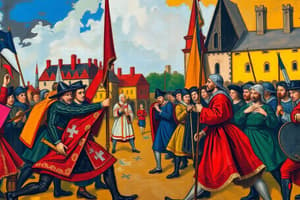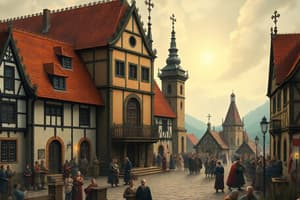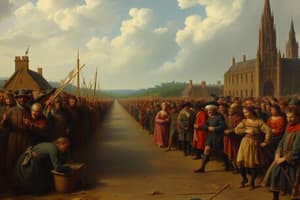Podcast
Questions and Answers
Why did the Thirty Years' War start?
Why did the Thirty Years' War start?
The Thirty Years' War began when Holy Roman Emperor Ferdinand II of Bohemia attempted to reduce the religious activities of his subjects, sparking rebellion among Protestants.
Where did most of the war take place?
Where did most of the war take place?
The war was primarily on German soil.
How did the war end?
How did the war end?
The war ended with a series of treaties making up the Treaty of Westphalia.
What were some effects of the war?
What were some effects of the war?
What was the significance of the Battle of White Mountain?
What was the significance of the Battle of White Mountain?
What was the Edict of Restitution?
What was the Edict of Restitution?
Which treaty guaranteed the independence of numerous small German states?
Which treaty guaranteed the independence of numerous small German states?
Who was the leader of the Catholic forces that defeated the Protestants at the Battle of White Mountain?
Who was the leader of the Catholic forces that defeated the Protestants at the Battle of White Mountain?
Who was the brilliant general leading Imperial forces against the Danish?
Who was the brilliant general leading Imperial forces against the Danish?
Which treaty was largely responsible for ending the 'civil war' aspect of the Thirty Years' War?
Which treaty was largely responsible for ending the 'civil war' aspect of the Thirty Years' War?
Which nation generally stayed out of the Thirty Years' War?
Which nation generally stayed out of the Thirty Years' War?
Which two Scandinavian countries intervened on behalf of the Protestants?
Which two Scandinavian countries intervened on behalf of the Protestants?
Who led the Danish forces that were defeated in the Danish phase?
Who led the Danish forces that were defeated in the Danish phase?
What battle was fought outside of Prague and ended the first phase of the Thirty Years' War?
What battle was fought outside of Prague and ended the first phase of the Thirty Years' War?
Who was the Holy Roman Emperor during the Thirty Years' War?
Who was the Holy Roman Emperor during the Thirty Years' War?
Who was the King of Bohemia who had the same title returned after the first phase?
Who was the King of Bohemia who had the same title returned after the first phase?
Which treaty specifically dealt with recognizing Dutch independence as part of the larger Peace of Westphalia?
Which treaty specifically dealt with recognizing Dutch independence as part of the larger Peace of Westphalia?
Which empire lost its northern provinces as a subsidiary part of the Thirty Years' War?
Which empire lost its northern provinces as a subsidiary part of the Thirty Years' War?
What was the battle where the Catholic forces of Wallenstein defeated the Protestant forces of Ernst von Mansfeld?
What was the battle where the Catholic forces of Wallenstein defeated the Protestant forces of Ernst von Mansfeld?
Which two powerful states represented the Catholic Hapsburg?
Which two powerful states represented the Catholic Hapsburg?
Who was the leader of the Protestant Union elected as King of Bohemia during the first phase of the war?
Who was the leader of the Protestant Union elected as King of Bohemia during the first phase of the war?
Which family ruled France during the Thirty Years' War?
Which family ruled France during the Thirty Years' War?
Who was the Italian Cardinal who became the chief adviser in France in 1642?
Who was the Italian Cardinal who became the chief adviser in France in 1642?
Flashcards
Thirty Years' War Cause
Thirty Years' War Cause
Emperor Ferdinand II's attempt to limit Protestant practices in Bohemia sparked the war.
Thirty Years' War Location
Thirty Years' War Location
Predominantly fought in Germany, causing widespread destruction.
Treaty of Westphalia
Treaty of Westphalia
Series of treaties ending the Thirty Years' War, reshaping European political landscape.
Political Restructuring (30 Years' War)
Political Restructuring (30 Years' War)
Signup and view all the flashcards
Treaty of Westphalia - German States
Treaty of Westphalia - German States
Signup and view all the flashcards
Battle of White Mountain Outcome
Battle of White Mountain Outcome
Signup and view all the flashcards
Wallenstein's Role
Wallenstein's Role
Signup and view all the flashcards
Treaty of Prague
Treaty of Prague
Signup and view all the flashcards
England's Role (30 Years' War)
England's Role (30 Years' War)
Signup and view all the flashcards
Sweden and Denmark's Role
Sweden and Denmark's Role
Signup and view all the flashcards
Christian IV of Denmark
Christian IV of Denmark
Signup and view all the flashcards
Edict of Restitution
Edict of Restitution
Signup and view all the flashcards
Treaty of Muenster
Treaty of Muenster
Signup and view all the flashcards
Ferdinand II (30 Years' War)
Ferdinand II (30 Years' War)
Signup and view all the flashcards
Frederick II (30 Years' War)
Frederick II (30 Years' War)
Signup and view all the flashcards
Bourbon Family
Bourbon Family
Signup and view all the flashcards
Cardinal Mazarin
Cardinal Mazarin
Signup and view all the flashcards
Spain's Loss (30 Years' War)
Spain's Loss (30 Years' War)
Signup and view all the flashcards
Battle of Dessau Bridge
Battle of Dessau Bridge
Signup and view all the flashcards
30 Years War Consequences
30 Years War Consequences
Signup and view all the flashcards
Study Notes
Causes and Context of the Thirty Years' War
- The Thirty Years' War lasted from 1618 to 1648, starting due to Holy Roman Emperor Ferdinand II's efforts to limit Protestant religious practices in Bohemia.
- Protestants rebelled against Ferdinand II’s actions, igniting conflict.
Geographic Focus
- The war predominantly took place in Germany, which faced extensive devastation during the conflict.
Conclusion of the War
- The conflict was resolved through a series of treaties known as the Treaty of Westphalia.
Consequences of the War
- The war led to significant political and religious restructuring in Europe, reconfiguring power dynamics.
- The Treaty of Westphalia both ended hostilities and guaranteed the independence of various small German states.
Key Battles and Leaders
- The Battle of White Mountain was a crucial victory for Ferdinand II, consolidating Hapsburg power by suppressing Protestantism in the region.
- Wallenstein, a skilled general, led Imperial forces against the Danish but was eventually assassinated by his own captain.
- The Treaty of Prague largely concluded the civil war aspect of the conflict.
Political Powers Involved
- England remained largely uninvolved throughout the Thirty Years' War.
- Sweden and Denmark intervened militarily on behalf of Protestant factions.
- Christian IV of Denmark led his forces but faced defeat during the Danish phase of the war.
Political Changes and Treaties
- The Edict of Restitution aimed to reclaim Catholic church lands taken by Protestant rulers.
- The Treaty of Muenster, part of the larger Peace of Westphalia, recognized Dutch independence from Spanish control.
Historical Figures
- Ferdinand II was the Holy Roman Emperor and played a central role during the conflict, reasserting Catholic influence.
- Frederick II of the Protestant Union was elected as King of Bohemia but lost power after early defeats.
- The Bourbon family governed France during this period, with Cardinal Mazarin serving as the chief advisor by 1642.
Additional Notes
- Spain lost control of the Netherlands as a consequence of the war.
- The Battle of Dessau Bridge marked a pivotal moment where Wallenstein's forces triumphed over Protestant forces.
This summary captures essential aspects of the Thirty Years' War, including its causes, geographic context, key figures, significant battles, and its political aftermath.
Studying That Suits You
Use AI to generate personalized quizzes and flashcards to suit your learning preferences.




